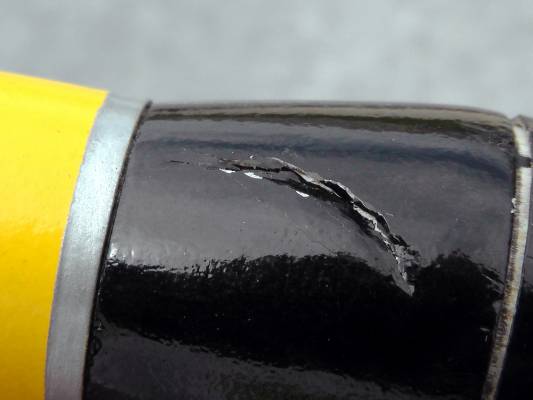The Vector Force: The Vector Force is a modern Estes kit. This was my first model I made as a BAR. It had very good quality balsa fins on my kit, thick and sturdy. You can see the design is inspired by air defense missiles. It is rather tall, but somewhat heavy because of the two reducers. Because it has two reducer stages it has two separate payload tubes. Estes tells you to glue the payload tubes, but why? Good idea if you want to be sure the rocket doesn't separate in flight, but why waste two very nice payload bays? I just make sure they are always good and tight with some masking tape. Mine is painted school-bus yellow and gloss black to better match the included decals. I added about 3 heavy coats of clear coat for a really deep shine. String stability tests with a C motor required about 20-ish grams of nose weight, but now it flies really straight up - provided there is little wind. The top payload tube has vent holes for a barometric altimeter. I've recorded flights in excess of 400 feet with C6 motors. This is my current go-to flagship rocket. I have tried some test flights with composite D engines, to see if I could kick this puppy past 1000 feet. It sure did! In the process, the shock cord was torn out from the mount. This model was repaired by installing a custom ejection baffle with a Kevlar shock cord attachment. Now I think she'll hold up to a few more D-powered launches and ejections. This rocket has flown higher than the NY Times Building in NY, and also the Chrysler Building including the pinnacle, and the Bank of America Plaza in Atlanta.
| Flight Date: | 2013-08-10 |
| Rocket Name: | Vector Force |
| Kit Name: | Estes - Vector Force {Kit} (003210) |
| Flyer's Name: | Rich DeAngelis |
| Motors: | C6-5 |
| Launch Site: | Downingtown Middle School |
| Actual Altitude: | 322 Feet |
Another test flight with reduced nose weight – 6.2 grams less than before in hopes that it performs better in winds. The previous flight with a C6-3 showed it could use more delay.
The C6-5 fired up and pushed the Vector off the rod at 6.8 Gs and then burned for 1.9 seconds. During the burn it averaged 1.9 Gs, and it did not turn into the wind much at all. At burnout the rocket was travelling at 77 mph, and it then coasted for 3.4 seconds where it turned a bit more into the wind – but not too much. It reached an apogee of 322 feet – not very impressive performance for a C6.
The rocket then turned over and fell for the next 1.5 seconds, dropping 32 feet before ejection fired at 4.9 seconds of delay. It was at 290 feet when the Nylon parachute opened up, and the rocket returned at 13 mph. Flight time as 21.3 seconds. The booster bounced off the top of a chain-link fence before landing, but it did not seem to hurt it. I did however find a nasty dent in the lower balsa reducer that was exactly the shape of the body tube opening.
Apparently it snapped back pretty hard after ejection. Still, a good flight.
| Stage | Motor(s) |
|---|---|
| 1 | Estes C6-5 |
Sponsored Ads
 |
 |













